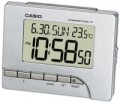Time format
The format in which the time is displayed on the clock face.
— 12 hours. A format that enumerates individual hours (time intervals) from 1 to 12. Since there are 24 hours in a day, this numbering covers only half of the day. This option is traditional for hand dials (see "Dial type") — historically, the full circle of the hour hand corresponds exactly to 12 o'clock, and it is from this principle that both watchmakers and watch users around the world today proceed. However, it can also be found in other types of dials. Theoretically, this option may require clarification — roughly speaking, "7 o'clock — in the morning or in the evening?" — however, in the vast majority of cases, the answer to such a question is clear immediately, from the context of the situation. But when using an alarm clock (see "Functions / Capabilities") in such a watch, you have to be especially careful: if, for example, at 6 pm you set the signal time to 8 am, the alarm clock will go off at 8 pm, because the clock itself "does not distinguish" between morning and evening.
— 24 hour. A full 24-hour format, provides numbering of hours from 1 to 24 (more precisely, from 0 to 23, because exactly 24 hours are considered zero of the next day). Thus, when looking at the clock, in principle, there is no question whether we are talking about the time of "morning" or "evening": for example, 7.00 will unambiguously correspond to morning, and "7 pm" will be designated as 19.00. At th...e same time, we note that such clarification can be provided in other ways — namely, the 12-hour scale, which has additional indicators AM (ante meridiem, "before noon") and PM (post meridiem, "after noon"). Therefore, models with such modified 12-hour scales are also classified as 24-hour models in our catalog. This format is used in all types of dials, except for arrows.
— 12/24 hour. This category includes watches that have the ability to switch between a full 24-hour clock and a 12-hour clock with "AM/PM" qualifiers. Formally, both of these types of scales are 24-hour scales (and are described in detail in the relevant paragraph above); the same designation is used to emphasize the possibility of switching formats.
Power source
Power supply methods provided in the design of radio receivers and table clocks.
-
Batteries. Powered by standard replaceable batteries (
AA,
AAA,
type C,
LR44,
PP3, etc.). There are two main advantages to this diet. Firstly, a shrunken element can be quickly replaced; for this, of course, you need to have fresh batteries in stock, but it’s easy to take care of this in advance. Secondly, consumer devices are independent of outlets; this allows you to install them on almost any suitable surface, easily move from place to place, without worrying about the length and placement of the mains cable. Batteries, of course, need to be purchased separately, which slightly increases spending. However, many replacement batteries are also available as rechargeable batteries. Thanks to all this, battery-powered models are very popular today.
-
Network. Powered by a standard 230 V network. On the one hand, this option eliminates the hassle of batteries, and on the other hand, connecting to the network is associated with a number of inconveniences: the power cord limits the ability to install a radio or clock in places where there are sockets nearby, moreover the device may interfere or simply not fit into the overall environment. Mai
...ns power in watches is quite rare in its pure form - much more often it is used as a fallback option for battery-powered models: if the situation allows, you can plug the watch into an outlet and not waste the charge.
- Battery. Powered by an original battery that is not related to standard sizes. Like the batteries described above, this option provides the device with autonomy. However, the key difference is that the battery, as a rule, does not provide for quick replacement: a non-standard format makes it difficult to purchase a spare battery, and more often than not, it is generally made non-removable. Therefore, the main, if not the only, option for discharging is charging, which requires a connection to the network and takes quite a long time. As a result, rechargeable batteries are considered a less suitable power option than replacement batteries and are rarely used.
